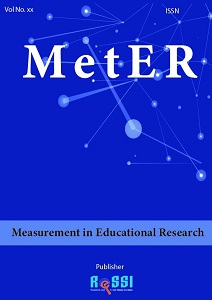Bagaimana model penilaian autentik berbasis proyek yang dikembangkan dalam mencapai kompetensi fisika peserta didik SMK?
DOI:
https://doi.org/10.33292/meter.v1i2.154Keywords:
penilaian autentik berbasis proyek, pencapaian kompetensi fisika, SMK, project-based authentic assessment, achievement of physics competence, Vocational High SchoolAbstract
Penelitian ini bertujuan untuk mengetahui (1) karakteristik model penilaian autentik berbasis proyek, (2) kelayakan model penilaian autentik berbasis proyek, dan (3) pencapaian kompetensi fisika peserta didik SMK menggunakan model penilaian autentik berbasis proyek. Prosedur pengembangan menggunakan model 4D dengan uji coba model pada 8 peserta didik kelas XI Teknik Instalasi Tenaga Listrik dan diujicobakan secara luas pada 21 peserta didik kelas XI Teknik Kendaraan Ringan SMK. Draft model divalidasi ahli dengan V Aiken= 0,829 (tinggi), validitas empiris mean INFIT MNSQ= 0,99 (fit), dan reliabilitas Alpha Cronbach= 0,607 (tinggi) sehingga diperoleh karakteristik model penilaian berbasis proyek meliputi penilaian kinerja dan sikap dilaksanakan saat pembuatan proyek; penilaian presentasi, produk proyek, dan pengetahuan di akhir kegiatan proyek. Berdasarkan hasil validitas dan reliabilitas, model penilaian autentik berbasis proyek dikatakan layak dan dapat digunakan untuk mencapai kompetensi fisika SMK materi medan magnetik secara signifikan dengan rerata 3,2 (baik).
Â
How is the project-based authentic assessment model developed to achieve the participants' physics competence in vocational high school students?
Â
Abstract: This research aims to know: (1) the characteristic of a project-based authentic assessment model, (2) the appropriateness of a project-based authentic assessment model, and (3) the achievement of physical competencies of vocational students using a project-based authentic assessment model. This research used the procedures of 4D models with 8 students of class XI Electrical Installation Engineering for testing the model and widely tested for 21 students of class XI Light Vehicle Engineering. The model draft was validated by experts with Aiken’s V= 0,829 (high), empirical validity means of INFIT MNSQ= 0,99(fit), and Alpha Cronbach reliability= 0,607(high) so could obtain characteristic of a project-based authentic assessment model consisted of performance and attitudes assessment which doing when making project; presentation, project products, and knowledge assessment at the end of the project activity. Based on validity and reliability, a project-based authentic assessment model was appropriated and could be used to achieve physics competence in vocational high school at magnetic field subject significantly with mean 3,2 (good).
References
Azwar, S. (2012). Penyusunan skala psikologi. Pustaka Pelajar.
Bagnato, S. J. (2007). Authentic assessment for early childhood intervention: Best practices. Guilford Press.
Bell, S. (2010). Project-based learning for the 21st century: Skills for the future. The Clearing House: A Journal of Educational Strategies, Issues and Ideas, 83(2), 39–43. https://doi.org/10.1080/00098650903505415
Brooks, V. (2002). Assessment in secondary schools. McGraw-Hill Education (UK).
Chiappetta, E. L., & Koballa Jr, T. R. (2014). Science instruction in the middle and secondary schools. Pearson.
Cumming, J. J., & Maxwell, G. S. (1999). Contextualising authentic assessment. Assessment in Education: Principles, Policy & Practice, 6(2), 177–194. https://doi.org/10.1080/09695949992865
Griffin, P., & Care, E. (2015). Assessment and teaching of 21st Century skills (P. Griffin & E. Care (eds.)). Springer Netherlands. https://doi.org/10.1007/978-94-017-9395-7
Harlen, W. (2007). Assessment of learning. A Sage Publiscations Ltd.
Harlen, Wynne. (2005). Teaching, learning and assessing science 5-12. Sage.
Krauss, J., & Boss, S. (2013). Thinking through project-based learning: Guiding deeper inquiry. Corwin Press.
Kurniawati, A., & Suryadarma, I. G. P. (2015). Penyusunan media pembelajaran berbantuan komputer untuk PBL dan keefektifannya terhadap CTS peserta didik SMA. Jurnal Inovasi Pendidikan IPA, 1(1), 57. https://doi.org/10.21831/jipi.v1i1.4532
Larkin, T. L. (2014). Making the case for alternative assessment: A writing-based rubric for self-reflection and improved learning. 2014 International Conference on Interactive Collaborative Learning (ICL), 901–907. https://doi.org/10.1109/ICL.2014.7017894
Mulyasa, H. E. (2007). Kurikulum tingkat satuan pendidikan (KTSP). PT Remaja Rosdakarya.
Muraki, E., & Bock, R. D. (1993). PARSCALE: IRT based test scoring and item analysis for graded open-ended exercises and performance tasks. Scientific Software International.
Murphy, D. (2002). Assessment in secondary schools: the new teacher’s guide to monitoring, assessment, recording, reporting and accountability. Improving Schools, 5(3), 61–61. https://doi.org/10.1177/136548020200500310
Purwandari, R. D. (2015). Physics laboratory investigation of vocational high school field stone and concrete construction techniques in the Central Java Province (Indonesia). Journal of Education and Practice, 6(11), 85–92.
Rosidin, U. (2008). Model penilaian otentik dalam pembelajaran ipa materi fisika sekolah menengah pertama. Universitas Negeri Yogyakarta.
Rosidin, U. (2017). Penilaian otentik. Media Akademi.
Subali, B., & Suyata, P. (2011). Panduan analisis data pengukuran pendidikan untuk memperoleh bukti empirik kesahihan menggunakan program Quest. Lembaga Penelitian dan Pengabdian pada Masyarakat UNY.
Thiagarajan, S., Semmel, D. S., & Semmel, M. I. (1974). Instructional development for training teachers of exceptional children: A sourcebook. may be ordered from the Council for Exceptional Children.
Wiggins, G. P. (1993). Assessing student performance: Exploring the purpose and limits of testing. Jossey-Bass.
Wilson, M. R., & Bertenthal, M. W. (2005). Systems for state science assessment. National Academies Press.







